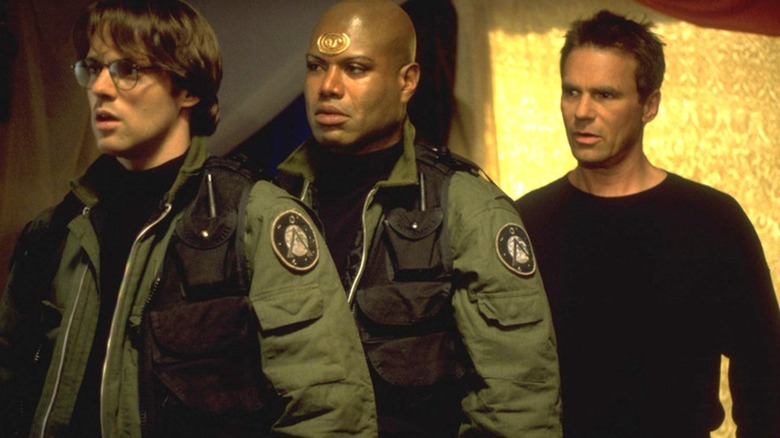How Stargate's Team Practically Created The Unstable Vortex Effect
This post contains spoilers for the "Stargate" franchise.
In Roland Emmerich's "Stargate," we see an energy vortex created by the titular device rush out of the gate like a pressurized flood. On its return trajectory, it takes the shape of a whirlpool attached to a small trail. Dubbed "strudel" by Emmerich, this vortex effect was unique to this 1994 film, as every franchise title that came after (especially the 10-season Syfy series "Stargate SG-1") opted for a slightly different visual effect to portray the same energy vortex.
If you've seen "SG-1", you might remember the enduring image of a massive burst of energy rushing through the Stargate right before it's ready for intergalactic travel, taking on the appearance of a high-pressure water fountain. Samantha Carter (Amanda Tapping) playfully refers to this unstable vortex as Kawoosh, as it forms as soon as the Stargate gears up, rushing through the rings and devouring anything in its path before subsiding back to its source.
The science behind the formation of this unstable vortex can get a bit tricky, but it can be best understood as a safety measure that facilitates stable travel after it dissipates back into the pool. Later on, we learn that the Tok'ra carry out their funeral customs by dissolving the dead in the path of the vortex, as its high-pressure velocity disintegrates anything it touches. As the episodes progress, we are privy to how this phenomenon is perceived by different factions, such as when those trapped in a prison planet (mistakenly) believed that this vortex could be used to travel backwards through a Stargate device. Other versions of this unstable vortex are seen in the Ori-made Supergate, which creates an even greater, more intense whirlpool due to the immense amount of energy it uses to propel itself forward.
But how was this Kawoosh effect created without the use of CGI? As you can already guess, the process was more complicated than it seems, as confirmed by "The Making of Stargate," a 1994 documentary that explains how this practical visual effect was first created in Emmerich's "Stargate."
The unstable vortex Kawoosh effect in Emmerich's Stargate was tricky to replicate
The 1994 documentary touches upon the Kawoosh effect, explaining how it was created by suspending an air cannon an inch above the surface of water. An air cannon can be utilized to generate compressed air, and in this instance, this compressed air was used to propel the water forward at a heightened velocity. This might sound simple, but it isn't, as a lot of variables need to be considered while staging such an important aspect of the Stargate activation process.
As Emmerich's film only shows the unstable vortex once (and follows it up with the strudel), the process was a one-and-done, which wasn't the case with "SG-1" due to its episodic format. The SG-1 crew would be using the device often, so it made sense for the show's visual effects team to figure out a way to replicate this convoluted method multiple times.
Per Gateworld, "SG-1" VFX supervisor John Gajdecki and his team underwent countless rounds of trial and error to recreate the shot from the film on the small screen:
"We set up an air cannon above, [but] we didn't know how much air pressure to use. We set the camera up, we set the lights up, we shot some tests, then we set the pressure at 50 pounds. So, we roll the camera at 120 frames per second, the water is as flat as we can make it, you push the button, and it lets the air go down the tube right into the water. Well, as it turns out, [the movie] used about 5 pounds, or 10 pounds. So 50 pounds just emptied the tank everywhere!"
After testing out different strategies, the crew figured out the optimal air pressure and the angles that would help capture it best, recreating the effect in a massive water tank. As this version of the unstable vortex did not come with the strudel, it was simply touched up with CG elements to evoke the image of a receding puddle.
Although Gajdecki and company could've used CG to create the effect in the first place, the "SG-1" team was always eager to take on challenging ideas and execute them with practical effects thrown in for good measure. Another example of their dedicated artistry is the decision to shoot the Arctic scenes in "Stargate: Continuum" on location, which has earned the franchise a still-uncontested spot on the Guinness Book of World Records.

